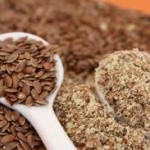 Adding some to flax to your diet can be a great way to boost your omega-3 fatty acid intake. Why is boosting your omega-3 fatty acid intake a good idea? Omega-3 fatty acids fall into the category of “good” fats and a diet high in omega-3s has been linked to a lower risk for heart disease and possibly cancer. Flax can be used in the diet in either seed, meal, or oil form; the use and benefits will vary slightly depending on form chosen.
Adding some to flax to your diet can be a great way to boost your omega-3 fatty acid intake. Why is boosting your omega-3 fatty acid intake a good idea? Omega-3 fatty acids fall into the category of “good” fats and a diet high in omega-3s has been linked to a lower risk for heart disease and possibly cancer. Flax can be used in the diet in either seed, meal, or oil form; the use and benefits will vary slightly depending on form chosen.
Seed: When eaten as intact seeds, flaxseed largely pass through the GI tract undigested and serves more as a source of dietary fiber than omega-3s. This is a different benefit to flaxseed but a benefit nonetheless. Adding seeds to baked goods, oatmeal, or cooked vegetables are easy ways to incorporate them into your diet.
Meal: When the seeds are ground into a meal, some of the fiber content is lost but this processing allows for the omega-3s to be available for absorption. Thus, flax in this form provides some fiber and some omega-3 benefits. Flaxseed meal can be used as an egg replacement in baked goods. To replace one whole egg, mix 1 Tbsp meal with 3 Tbsp warm water. Allow the mixture to sit for ten minutes to thicken slightly before use in the recipe.
Oil: In this form, all of the fiber has been removed and the oil is primarily a source of fatty acids. Never cook with flaxseed oil; add the oil after foods have been heated or in cold dishes, such salad dressings. Flaxseed oil can also be added to smoothies.
